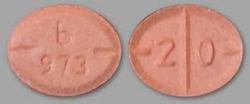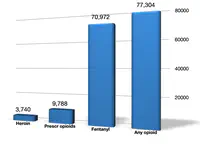A Hidden Killer, Illicit Adderall May Not Be Adderall At All
New and dangerous trends manifesting in the illicit drug use community reflect a dire need for addicts to seek treatment now.

It’s not a new development that synthetic fentanyl is being pressed into fake, OxyContin-looking pills to make counterfeit pills. This trend has led to more fentanyl deaths, because opioid addicts take the fake pills thinking they’re getting name-brand painkillers like OxyContin when really they’re getting fentanyl, a far more potent, addictive, and deadly opioid.
Unfortunately, this trend is now being replicated, this time with fentanyl being falsely advertised as stimulants. In recent years, there have been several instances of young people who took pills that they thought were Adderall, only to overdose and die because the pills were actually fentanyl.
Combined with other publications that indicate a doubling in teen drug overdoses, alarming developments like a surge in fake Adderall pills make it all the more clear that no one who uses drugs, no matter what drugs they think they’re using, is ever safe from the risk of an overdose.
New Developments in Drug Supply Create More Risk for Young Users

An alarming report came out of Ohio State University, a story that broke the news about two students dying from drug overdoses. These overdoses were different in that, while the toxicology reports indicated the students had died from opioids, the students had thought they were experimenting with Adderall pills, not opioids.1
Unfortunately, the Adderall was not really Adderall at all. It was illicit fentanyl, a potent opioid pressed into pill form and given labeling that made it look like Adderall. Also, it wasn’t just these students who had succumbed to the falsely advertised drug. Further investigation revealed that Columbus Public Health had been warning the community for some time of a rising trend in counterfeit pills labeled as Adderall.
Counterfeit pills are extremely dangerous. The Drug Enforcement Administration has reported that about 40% of counterfeit pills that contain fentanyl have a potentially lethal dose of the drug. According to the DEA, it only takes about two milligrams of fentanyl to cause a fatal overdose. Addicts who are consuming illicitly-obtained “prescription drugs” thinking those drugs are OxyContin or Adderall would have no way of knowing the pills had fentanyl in them.
Defining Counterfeit Pills

Courtesy of DEA.gov
While the attempt by drug dealers to trick Adderall users into taking fentanyl is a relatively new development, the use of fake pills to broadcast one type of drug into a community of addicts that are not seeking that drug is not anything new. Dealers do this to make the most profit possible by substituting a cheap powerful drug for more expensive drugs like heroin and in this case prescription pills. An unfortunate side effect of this is many users wind up hooked on opiates.
“Counterfeit pills may contain lethal amounts of fentanyl or methamphetamine and are extremely dangerous because they often appear identical to legitimate prescription pills, and the user is likely unaware of how lethal they can be.”
The Drug Enforcement Administration is charged with policing counterfeit pills. Their definition for these illegal narcotics reads as follows, “Counterfeit pills are fake medications that have different ingredients than the actual medication… Counterfeit pills may contain lethal amounts of fentanyl or methamphetamine and are extremely dangerous because they often appear identical to legitimate prescription pills, and the user is likely unaware of how lethal they can be.” Sadly, counterfeit pills are becoming a leading cause of drug overdoses.2
That same DEA report discussed how a growing number of young people are purchasing what they think is Adderall and Xanax on the internet, but what they ultimately get in the mail is illicit fentanyl, sometimes in lethal doses.
Fentanyl-Laced Pills Caused Teen Drug Overdose Deaths to More than Double in Just Two Years

Though drug overdose deaths among young people had been trending downwards for a decade, 2020 and 2021 experienced an alarming shift in overdoses, with fatal drug interactions amongst young people skyrocketing. According to a report published in JAMA Network Open, drug overdoses among adolescents soared from 492 fatalities in 2019 to 954 deaths in 2020, a 94% increase. Then, fatalities rose again in 2021 by 20%, totaling in 1,144 adolescent drug overdoses.3
Another element exacerbates the issue. Even though drug overdose deaths among teens rose by over 2.3X in just two years, drug usage rates among teens receded during this period.
Fewer young people are using drugs now than in previous years, but significantly more teens are dying from overdoses. This means teens are using far more dangerous drugs than in previous years, making them more likely to suffer an overdose.
Reports indicate that 77% of all teen overdose fatalities in 2021 involved fentanyl, often without the teen knowing they were using it.4
Residential Treatment is the Answer to Drug Addiction
Recent developments in the spread of fentanyl into drugs labeled as prescription stimulants are yet another indicator of the risk that addicts take when they use drugs. If nothing else, such developments show that no one who uses drugs is safe, no matter what drug the use. For all Americans, the spread of fentanyl into the drug supply should act as a stark warning to avoid all mind-altering drugs. Lives depend on it.
Sources:
-
U.S. News. “Ohio State Warns of Fake Adderall Pills After Two Students Die.” 2022. usnews.com ↩︎
-
JAMA Network. “Trends in Drug Overdose Deaths Among US Adolescents, January 2010 to June 2021.” 2022. jamanetwork.com ↩︎
-
NPR. “Teen drug overdose deaths rose sharply in 2020, driven by fentanyl-laced pills.” 2022. npr.org ↩︎





 ®
®